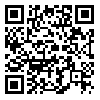Volume 30, Issue 190 (11-2020)
J Mazandaran Univ Med Sci 2020, 30(190): 34-43 |
Back to browse issues page
Abstract: (1378 Views)
Background and purpose: Guillain-Barre syndrome (GBS) is an autoimmune disorder that has different clinical and pathologic findings. Its diagnosis is based on clinical findings. This study aimed at investigating the characteristics of the disease in a region in north of Iran.
Materials and methods: In this descriptive-analytical study, the records (2008-2018) of children under the age of 15 years old admitted to a third level referral center due to GBS were studied. Demographic and clinical findings, laboratory, electrophysiological, medical history, and treatment records were investigated.
Results: During this period, 37 cases of GBS were admitted. There were 27 (73%) boys (P= 0.005). The median age was lower in boys (4 years) than girls (7 years) (P=0.034). Of these cases, 35.1% were recorded in winter, 29.7% in autumn, 18.9% in spring, and 16.2% in summer (P>0.05). The most common underlying conditions were upper airway infections (59.46%, n=22), followed by diarrhea (24.3%, n=9). Among the cases, there were 54.1% afebrile. The most common neurological findings were muscle weakness (97.3%), limping (75.7%), and ataxia (37.8%). The most common forms of the disease were demyelinating (64.9%), motion-sensory-axonal (21.6%), and motion-axonal (13.5%). In those with demyelinating type, 79% recovered completely.
Conclusion: In our study, boys were admitted more often than girls due to GBS, and the age of onset was lower in boys. The demyelinating form of the disease was the most common form which was associated with best neurological prognosis.
Materials and methods: In this descriptive-analytical study, the records (2008-2018) of children under the age of 15 years old admitted to a third level referral center due to GBS were studied. Demographic and clinical findings, laboratory, electrophysiological, medical history, and treatment records were investigated.
Results: During this period, 37 cases of GBS were admitted. There were 27 (73%) boys (P= 0.005). The median age was lower in boys (4 years) than girls (7 years) (P=0.034). Of these cases, 35.1% were recorded in winter, 29.7% in autumn, 18.9% in spring, and 16.2% in summer (P>0.05). The most common underlying conditions were upper airway infections (59.46%, n=22), followed by diarrhea (24.3%, n=9). Among the cases, there were 54.1% afebrile. The most common neurological findings were muscle weakness (97.3%), limping (75.7%), and ataxia (37.8%). The most common forms of the disease were demyelinating (64.9%), motion-sensory-axonal (21.6%), and motion-axonal (13.5%). In those with demyelinating type, 79% recovered completely.
Conclusion: In our study, boys were admitted more often than girls due to GBS, and the age of onset was lower in boys. The demyelinating form of the disease was the most common form which was associated with best neurological prognosis.
Type of Study: Research(Original) |
Subject:
children
| Rights and permissions | |
 |
This work is licensed under a Creative Commons Attribution-NonCommercial 4.0 International License. |



